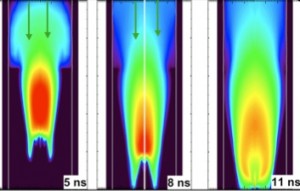Sun on Earth

A sequence of false color images generated from a numerical simulation show a MagLIF liner as it is heated by a laser in preparation for an implosion.
On the last Friday before Christmas in 2010, fusion physicist Steve Slutz was in his office at Sandia National Laboratories’ Albuquerque, N.M, location, doing what he’s been doing for the past 34 years: crunching the numbers to get fusion to work on Earth.
This time around, he was calculating the potential fusion energy output from a large-scale version of a new fusion process he and his colleagues had proposed. He’d already shown that magnetized liner inertial fusion, or MagLIF, could theoretically produce enough fusion energy to make it useful for weapons-effects simulations.
Still, if he could show that MagLIF had potential as a large-scale fusion energy source, that could be the added push it needed to get the green light for experiments. That was the problem. Most earlier research by others had dismissed the possibility.
Slutz wanted to see for himself. For MagLIF to go big, he knew he needed a gain in energy of at least 50 times that needed to kick-start the reaction. Hunched over his keyboard, making the calculations, he realized it was possible – with the right technology. He went to a colleague in a neighboring office – one of the few people left in the building – to share this physics good news.
“Go home quick before you figure out what’s wrong with it,” the colleague joked.
Instead, Slutz returned to his calculations and found that, given the right circumstances, MagLIF could produce an energy gain of 1,000.
At which point there was no one at Sandia left with whom to share the news.
Today dozens of Sandia researchers are at work testing MagLIF, seeing if what Slutz’s computer simulations show is indeed a path to fusion that could one day actually power your Christmas lights.
“The message is that MagLIF is a really interesting path because in principle you could have really high gain,” Slutz says. “If this thing works at all.”
Fusion grand slam
Every day you’re bathed in the light and heat of fusion energy. The sun’s massive gravitational self-hug and the resulting sizzling temperatures fuse hydrogen nuclei, releasing vast amounts of energy in the process.
Yet achieving controlled fusion on Earth has proven to be a 60-years-and-counting grand challenge.
The trouble is that controlled fusion is the equivalent of the ultimate baseball bases-loaded grand slam. To make it work, researchers have to take a little bit of star fuel, then heat it, hold it and get it to heat itself for long enough to extract the fusion energy. All this with a fuel that’s heated to a plasma hotter than the interior of the sun – more than hot enough to melt any terrestrial material.




